
EDITOR’S NOTE: Tomorrow is the release date for TOM & JERRY: THE GENE DEITCH COLLECTION. Considering the sorry state of the DVD business – at least among the major studios – this may be the last classic theatrical cartoon collection from Warner Bros. to feature restored cartoons and include a bonus documentary.
Gene Deitch has been candid about his work on these cartoons, as you will see on the bonus doc – and in the exclusive piece he has written for Cartoon Reseach below. For me – I’ll just say that there is much to enjoy in Deitch’s Tom & Jerry films. From the cock-eyed animation, to the voices of Allen Swift (“Dickie Moe” in particular). The prints of these cartoons in circulation for decades always looked like dupes of dupes – and I’ve accepted that because, heck, they were made in Prague and I figured we were watching some second generation version. The restorations on this DVD are surprising, as it is the first time we see them crystal clear and bursting with color. For that alone, it is worth having in your collection.
Here in his own words, Gene Deitch recalls his feelings about Tom & Jerry and his many memories of that production year. Thanks, Gene. – Jerry Beck
When I flew to Hollywood to present our first trial Tom & Jerry film, it was in fact a weird situation; as if we were speaking different languages. Our assignment was actually a test, to see if we would be awarded a contract for the full 13-film package. In spite of my negative feelings about the T&J cartoons, as being senselessly violent, and downright racist, I knew this was a crossroad, and though I hadn’t asked for this assignment, I was under pressure to accept it, and I became determined to make a success of it. Our career and personal lives were on the line; so I put everything I had into it.
When the lights came up in the other-worldly MGM executive screening theater, Head-Hocho Joe Vogel took a deep drag on his stogie, and said, “You don’t need to build such expensive sets! ‘Right away, it was clear that these 6-figure honchos didn’t have the faintest ideas how cartoon films were made. It didn’t cost a nickel more if our background painter put a castle or a hovel on the Strathmore background paper!Vogel loved our effort, especially because he was proud that he had lucked onto a first rate foreign animation studio which could crank out such an elaborate T&J cartoon for half the H&B cost! So we got the job. He loved what we did. We could have continued on if Joe Vogel had stayed in charge. But he was de-Metro-ed, and as we were “his,” we went out with him. That’s how Hollywood worked, and still works
The fact that I was the very first director chosen to continue T&J, following the great successes of Hanna Barbera, and my episodes got loud laughs in the theaters, it didn’t cut any ice. The new executive leadership chickened out on a communist country issue, so the great Chuck Jones took over. Whereas I had scrupulously attempted to follow the H&B character model sheets, Chuck didn’t bother to, but made them his own.
The one and only issue I had with Joe Vogel was the title of our pilot episode. Over my bruised body, it went out with the totally idiotic title, Switchin’ Kitten. My original title was “Dog My Cats”. As the story centered on a mad scientist turning cats into dogs, I thought my title was funny and apt. Besides being a play on words, it was actually about the story! But the mighty Metro moguls simply didn’t get it.
I am painfully aware that my Tom & Jerry cartoons were savaged by most of the critics and hardcore H&B fans. I was the first animator to continue the series, and obviously I was in the line of fire. I had every possible disadvantage in producing these shorts; 1. my own negative T&J feelings at the time. 2. working in a foreign country, with the first non-USA, studio ever to tackle this hyper-American series, with a crew that was creatively isolated; way out of the helter-skelter, crash-bang American T&J cartoon culture, and 3. with a dollar budget half the amount of the original MGM series.Not only had no one in the Prague animation studio ever even seen a Tom & Jerry cartoon, but I had never tried to draw the characters! They were out of my way of drawing. I did admire the skill of the Disney shorts, and I was a great fan of the brash comedy of the Warner Brothers output. But as gross as many of the Hannah Barberra cartoons were, the outrageous pain the Tom and Jerry characters inflicted on each other did make me laugh out loud.
Being assigned to recreate Tom & Jerry, I knew that I had a tough act to follow. I resolved to make them look as much like the late period Hanna Barberra originals as I possibly could. H&B themselves had of course altered the models and animation style as they went along. I tried to continue the look of their later series., using the final MGM model sheets as my starting point.. I was determined that audiences would accept my recreations as really being Tom & Jerry! I could not worry what the critics would think. Without question, times had changed, even in 1961. And some aspects of T&J had to change also. I drew the line at the H&B racial gaffs. I immediately retired the black housemaid. I tried for fresh venues in the stories. Fortunately, H&B had also ventured out of the household, with period pieces and exotic locations, so I did have some wiggle-room in stories.
In those early days for me in Prague, the studio was using architect’s translucent “vellum” for their animation drawings. You can tell by the yellowish color of the paper. The Czech artists claimed that the translucency help them with the animation. We in America had the opposite opinion, and this fragile paper was not worth the downside; the vellum was so brittle that every sheet required peg-hole reinforcements! The inbetweens could not be hand-flipped to test the action. I ultimately switched them to white bond paper, and right on the Tom and Jerry series they were gradually adapting to the paper every American animation studio was using.
Because of the difficulty of keeping the Czech animators on-model, I personally drew every key pose in the entire 13-film series. If they don’t look like Tom & Jerry, you can blame me! The movement was another thing. Sometimes the Prague animators got it, and sometimes they didn’t. We sweat-shopped the pencil tests to the maximum money and time would allow.
 I often tell film students and others that I have always considered the soundtracks as at least 50% of the movies. Obviously, there was no digital recording anywhere in those days, but here is was dreadful, working with Soviet equipment! They used sprocketed 55mm East German coated sound film.
I often tell film students and others that I have always considered the soundtracks as at least 50% of the movies. Obviously, there was no digital recording anywhere in those days, but here is was dreadful, working with Soviet equipment! They used sprocketed 55mm East German coated sound film.
What I couldn’t tell anybody at the time is that I brought my own Ampex 1/4” tape recorder into the studio, and recorded the orchestras myself, with little more than a volume control and only two microphones, all my own property! The engineers here thought I was crazy, but I got brighter results than they did. (They had only one-channel mono recording. I recorded all the tracks in stereo. Stereo did not exist here at all in 1961! I also created all the sound effects at home, except the sounds Tod Dockstader made, and sent me on quarter-inch tape!
I can only imagine how far we would have gotten, if a half-century ago MGM knew that the entire soundtracks of our Tom & Jerry sound tracks, including the symphony orchestra for Carmen Get It, were recorded on an Ampex 601-2 recorder, no bigger than a carry-on suitcase! And that all my tracks were edited and mixed in our tiny bachelor apartment in communist Prague!
Here’s another sidelight that hasn’t come up before: In Buddies Thicker Than Water, the drunken giggling of both Tom and Jerry, as well as other coo-coo vocal effects throughout the series, are by me.
In conclusion – I didn’t seek the job. MGM picked me to do it, because I’d just made an Oscar-winning short and had a string of nominations – but mainly I suppose, because my producer Bill Snyder accepted their low, low budget! I hardly had a chance to succeed. They could all have been better animated – truer to the characters – but our T&Js were produced in the early 1960s, near the beginning of my presence here, over a half-century ago as I write this!
I actually received an unsigned death-threat from a furious Tom & Jerry fan, who wrote that I “deserved to die” for what I did to this noble duo! I hope by now that tempers have cooled!
BONUS MATERIALS
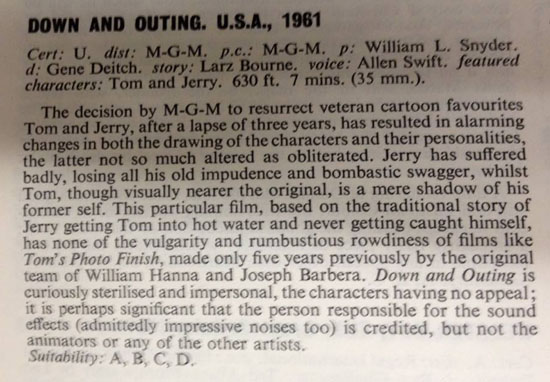
Review of a Deitch Tom & Jerry cartoon from the British “Monthly Film Review“, August 1962 (via Tony Perodeau)
The Prague Tom & Jerry team, 1961
William L. Snyder contractor with MGM
Gene Deitch project director/designer*
The Prague studio staffers on our 1961 Tom & Jerry series:
Zdenka Najmanová* – project producer & managerLudvika Kopečná – assistant to producer
Václav Bedřich – animation group leader
Milan Klikar – animator
Zdenek Smetana – animator
Jindra Barta – animator
Antonin Bureš – animator
Mirko Kačena – animator
Věra Kudrnová – animator
Olga Šišková – animator
Věra Marešová – animator
Zdenka Skřipková – animator
Bohumil Šiška – background painter
Miluše Hluchoničová – assistant background painter.
Ludmila Kopecná – animation checker
Zdenka Navratílová – film assembling & editing, with Gene
Zdenka Hajdová – camera
Václav Lídl – composer of music
Stěpan Koniček – composer of music
Of the 13 core personnel on the Tom & Jerry project there was a large group of superb inkers & painters – all women – whose names I didn’t preserve. Sorry for that!
Aside from being the leader and editor of the writing staff, I also directed the voice actor, Allen Swift, and the musicians, composers and sound effects. The sounds were created by Tod Dockstader and me. I drew the production layouts, including all animation key poses, edited and mixed all the soundtracks, and generally swept up the studio after everyone went home.
* Zdenka Najmanová is now Zdenka Deitchová
INDIVIDUAL FILM CREDITS (in Production Order)
* Gene Deitch. I worked personally on every phase of the project, refining the submitted storyboards, designing the backgrounds, drawing all key animation poses, writing and directing dialog and narration., directing musical composing and recording, creating sound effects, voice recording, and mixing sound tracks.
SWITCHIN’ KITTEN 1960
Story Eli Bauer & Gene Deitch
Layout Lu Garnier & Gary Mooney
Sound Effects Tod Dockstader
Music Václav Lidl
Sound Effects Tod Dockstader
Voice Allen Swift
Music Stěpan Koniček
IT’S GREEK TO ME-OW! 1961
Voice Allen Swift
Sound Effects Tod Dockstader
Music Stěpan Koniček
HIGH STEAKS 1961
Story Larz Bourne
Voice Allen Swift
Animation Václav Bedřich*
Music Stěpan Koniček
MOUSE INTO SPACE 1961
Story Tod Dockstader
Animation Václav Bedřich
Music Stěpan Koniček
LANDING STRIPLING 1961
Story Eli Bauer
Animation Václav Bedřich
Music Stěpan Koniček
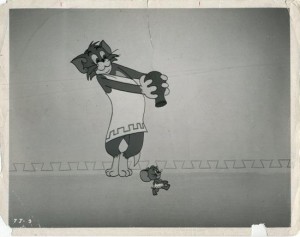 CALYPSO CAT 1961
CALYPSO CAT 1961
Story Larz Bourne
Animation Václav Bedřich
Music Stěpan Koniček
SORRY SAFARI 1961
Story Larz Bourne
Music Stěpan Koniček
Voice Allen Swift
CARMEN GET IT! 1961
Story Gene Deitch
Music Stěpan Koniček
Czechoslovak Symphony Orchestra!
DICKY MOE 1961
Story Eli Bauer Gene Deitch
Voice Allen Swift
Animation Václav Bedřich
Music Stěpan Koniček
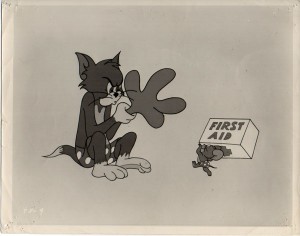 TALL IN THE TRAP 1961
TALL IN THE TRAP 1961
Story Tedd Pierce Bill Danch
Voice Allen Swift
Music Stěpan Koniček
Guitar Jiří Jirmal
BUDDIES THICKER THAN WATER 1962
Story Larza Bourne
Music Stěpan Koniček
Annimation Václav Bedřich
THE TOM & JERRY CARTOON KIT 1962
Story Chris Jenkyns
Voice Allen Swift
Music Stěpan Koniček
Animation Václav Bedřich
*Bedřich was in fact Animation Group leader for all the films
MODEL SHEETS
I found these crumpled model sheets in my files. I probably intended to throw them away.


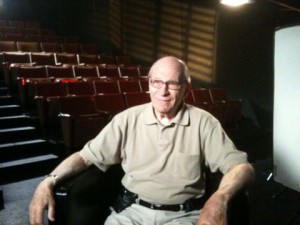

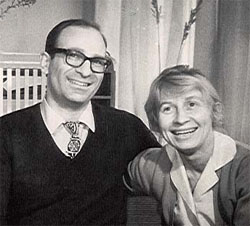

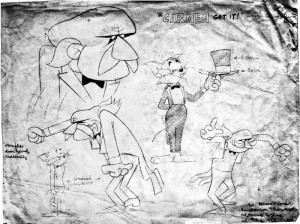
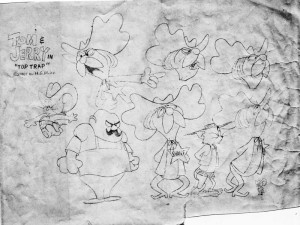
 Gene Deitch is a cartoonist and Oscar winning animator who created such beloved characters as Tom Terrific, Silly Sidney and Nudnik. Gene was the director of UPA New York, the creative supervisor at Terrytoons (1956-58) and the acclaimed producer of hundreds of shorts for Weston Woods. He passed away April 17th, 2020, in Prague.
Gene Deitch is a cartoonist and Oscar winning animator who created such beloved characters as Tom Terrific, Silly Sidney and Nudnik. Gene was the director of UPA New York, the creative supervisor at Terrytoons (1956-58) and the acclaimed producer of hundreds of shorts for Weston Woods. He passed away April 17th, 2020, in Prague.











































The Tom and Jerry Cartoon Kit was one of my all time favorites Gene Deitch T&J cartoons – as well as Mouse into Space and that western parody Tall in the Trap. That one grumpy fellow that was in High Steaks and Sorry Safari looks like the “cranky brother” from Terrytoons’ Clint Clobber!
Cartoon Network’s program Toon Heads had a program that talked about Gene Deitch’s Tom and Jerry cartoons being animated in Czechoslovakia (Now the Czech Republic and Slovakia ) while being under controlled by the Soviets which was incorrect. The Soviets invaded Czechoslovakia in 1968 six years after that last Tom and Jerry cartoon was made there. Also Gene Deitch should be relived that Filmation did the animation for Tom and Jerry in 1979 – the animation was a disaster in the making!
There was definitely a difference there. At the time these cartoons were made in Czechoslovakia, while still firmly behind the “Iron Curtain,” Czechoslovakia operated as a more uniquely autonomous satellite state that wasn’t directly governed by the USSR.
Only when recent Prague-led reforms in 1968 got the Soviets paranoid that it would potentially leave the Warsaw Pact and sent in the troops did the country become truly governed by the USSR.
I have to wonder what the Czech crew made of the American station wagon and barbecue consumer culture of the early ’60s in High Steaks and others like it?
The Deitch cartoons always seemed like the poor man out way back when I was rediscovering Tom & Jerry (and Droopy) cartoons on Dwayne & Floppy at the turn of the ’80s.
Then there was Chuck Jones’ technically proficient but not quite on key take on T&J.
That was an interesting time, really. There’s a couple docs. on the “Prague Spring” worth checking out on YouTube that should address these questions pretty well. 1968 was quite a roller coaster descent into heck the way it started out great but ended in tragedy.
https://www.youtube.com/watch?v=BlPT3O7NKIQ
That is an interesting question at that. I don’t suppose Deitch may recall what they thought, or if they even tried to think about it. Some may even not had an interest in any of that at all. I recall much of this is discuss in Gene’s book, “For The Love of Prague” that I recommend checking out.
It did felt that way to me too. More or less, there was a time when some stations chose to not show those 13 cartoons at all so I never saw them unless they aired on WTBS out of Atlanta.
Those were a whole new world altogether.
The Deitch cartoons always seemed like the poor man out way back when I was rediscovering Tom & Jerry (and Droopy) cartoons on Dwayne & Floppy at the turn of the ’80s.
Hey, Doug! You must be another fellow Iowan if you referenced the Floppy Show from Des Moines.
Man, people hate, HATE these even to this day. I imagine they got a good reaction in the Soviet Bloc where the original H&Bs were almost never screened, but to those who were fond of the originals these (and to a lesser extent the Chuck Jones films) like the plague. Even this Gene Deitch post/interview looks like one long apology, explaining “why these aren’t good”
Don’t think Mr. Deitch can take credit for getting rid of the black housemaid, Mammy. She was already phased out long before the H-B era ended, with her last appearance being “Push-Button Kitty” in 1952. Times were changing. Better phrasing would be that these shorts didn’t revive her (for obvious reasons), though it’s interesting to note that Gene apparently had the option of using her.
Also I agree this is very likely the last gasp from WHV regarding newly restored classic cartoons on DVD/blu-ray. At this time, I don’t see Popeye vol 4 happening at all until possibly 2017….and even that is extremely wishful thinking at this stage
Anyway, I’ve never seen most of these and should get the set Tuesday and enjoy them in their own bizarre little way.
If I recall Gene Deitch also did one Popeye Cartoon back in the 1960’s for King Features (it was when Popeye and Olive Oyl when on a holiday on a somewhat abandoned island and the male Goons (that look like the Goons from Goonland) kidnap Olive) Also Gene Deitch did Alice in Wonderland in Paris (aka Alice in Paris) in 1966 starring Norma MacMillian,Carl Rainer, Howard Morris and Allen Swift in a series of children stories that included Anatole and Madeline. My favorite segment from the film was James Thuber’s Many Moons with the Jester that look almost like Johnny Depp (even though he was only three years old when the movie came out but how Johnny Depp would look like in the future!)
Even though the maid wasn’t appearing in the final years of newly-produced Hanna and Barbera cartoons, the studio was issuing Gold Medal Reprints of the older cartoons to theatres and some of them would have included her. So, as far as movie audiences were concerned, she hadn’t really retired.
Not sure if these were even played behind the Iron Curtain particularly. At least I’m not sure how American studios got around those deals during the time. The only country I could see picking this up int he 60’s was Yugoslavia, which wasn’t under Soviet control or a Warsaw Pact nation.
It wouldn’t surprise me if MGM thougth Mammy was still a viable character and sent that along in a memo to Gene.
Yowp said…
I’d believe that. Some things are hard to shake off if they’re still kept in the public eye.
Chris, I grew up in the former Yugoslavia and don’t remember Deitch’s Tom and Jerry ever playing on TV or in theatres (I regularly watched cartoons shown on the state-run TV Sarajevo, TV Zagreb, and TV Belgrade in the late 1970s and throughout the 1980s). The original Hanna-Barbera cartoons, Chuck Jones’ 1960s adaptation of the duo, and the later Hanna-Barbera TV incarnation titled ‘The Tom and Jerry Show’ were regularly shown, however. As you astutely pointed out, Yugoslavia was not under the Soviet block nor was it a Warsaw Pact member, so this may have something to do with that.
I like these okay, Deitch was a fine talent and the best with what he had. As you can tell, he’s not in love with these, either.
I’ll definitely get this set tomorrow!
As much flak as these cartoons get, they are (except for “Down and Outing”) at least watchable, and I’d argue that “Carmen Get It!”, “The Tom and Jerry Cartoon Kit”, and the short that should have been titled “Dog My Cats” are genuinely good. That’s a better batting averate, IMHO, than the last couple of years of HB shorts. And if we’re going to judge them by the conditions and budgets under which they were produced, then they’re actually fairly impressive. Thanks for giving it your all even when you didn’t care for the characters, Gene! Though I admit to being curious: are there any of these shorts that you’re particularly proud of, or at least particularly happy with?
Bring back Tom Terrific!
Well, I’m going to get it anyway. There are some good ones in this odd period for the cat and mouse.
Going off-topic, I got a question for Gene regarding Terrytoons, In “Old Mother Clobber”, when Clint is cleaning of the graffiti the little girl drew on one of the walls, he grumbles that for forty years the walls were unchanged, now someone wanted something new. Was that a riff on what the old Terrytoons staff thought of you running the studio?
I’ll be happy to have this set. Sure, H-B T&Js are untouchable, but Deitch’s are way better than Jones’. They’re quirky and goofy – you know, like a CARTOON. Jones’ play more like a college-level drawing class; borrrrrrring.
Gene Deitch has had a fine career, worthy of praise. He gave Terrytoons a much-needed lift. Well done!
I like the Chuck Jones version better than the crud that Filmation came out when they did Tom & Jerry back in 1979.
Fun Fact # 1 There was only one Tom and Jerry cartoon that Chuck Jones didn’t do during his tenure for MGM and that was Matinee Mouse, with Hanna and Barbera clip footage from some of the classic T&J cartoons of the 1940’s and 1950’s along with new footage (by Tom Ray) as wraparounds (including a cameo of Droopy on a movie poster for “The Sand Paupers”).
Fun Fact # 2 William Hanna did some VO work on several of the early Tom and Jerry cartoons, as did Paul Frees, Daws Butler and June Foray in the 1950’s (including June’s slightly awkward Irish accent for Mammy when Tom and Jerry was first broadcast in the mid 1960’s on CBS); Gene Dietch had Allen Swift in the early 1960’s (whom he previously worked with at Terrytoons), and Chuck Jones had Mel Blanc & June Foray (returning for her second run) doing VOs.
I think there was one other cheater using H-B footage that Tom Ray did in addition to “Matinee Mouse.” Ray also did the intros and bumpers for the CBS Tom & Jerry show in the ’60s.
It might have been Ray who changed “Mammy” to a slender white maid, who was overdubbed by June Foray with an Irish accent. But I have seen some prints of T&J cartoons where one heard the black maid but saw the white one, and vice versa.
My only real beef with the Chuck Jones T&Js is that he used ideas he had done before, and better, at WB.
GD0 wrote:
College-level drawing class, that is a good way to describe Jones’ set. His cartoons certainly weren’t really funny at all, they seem like thesis of animation layout and timing.
BIGG3469 wrote:
That’s all they were, cheaters and inserts. And yes, Ray had to make those changes for the TV version of those cartoons Mammy was in.
That happened with “Saturday Evening Puss“. The cartoon replaced Mammy with a teenager girl of sorts going out on a date who, because of the mismatched soundtrack used in the 80’s, caused her to sound like a black woman when she answered the phone with “Yes, this is the Lucky Seven Saturday Night Bridge Club.” when she was clearly dancing with her boyfriend! Still I liked the added humor of her appearing to bowl over her boyfriend when he left.
*sigh* Pretty much. There was nothing new he brought to the plate on those.
“My only real beef with the Chuck Jones T&Js is that he used ideas he had done before, and better, at WB.”
Name me a Warners cartoon that had a mouse-sized dog in it. I sure don’t recall one. A tiny elephant, yes, but not a dog.
Changing Dinah the maid to a slender white teenager wasn’t done for all of the cartoons with the character. Some changed her to a fat white maid, basically keeping the same character design and only changing the skin color. And the Saturday morning version of “Mouse Cleaning” (which used to be on YouTube) left her unaltered, including Lillian Randolph’s voice; the only new animation was Tom coming out of the coal, so he wasn’t in blackface.
I could never understand the point of changing her to a slender teenager for “Saturday Evening Puss”. That slender body didn’t fit with the violence inflicted on Tom and his buddies at the end of the cartoon. (I hope they didn’t also do that for the Saturday morning version of “Part Time Pal”.)
“Carmen Get It” and “Dicky Moe” were my faves from the Deitch era. Quirky as all hell and I loved it! The Jones cartoons were nice to look at and all, but they just weren’t funny to me. The 1970’s era T & J revived by HB on the other hand….make me want to throw up every time I see them.
And don’t forget the Filmation’s fiasco of Tom and Jerry from 1979! Heavens they were awful!
Mr. Deitch, if it’s anything, I also enjoy your T&J shorts. I don’t want go into a long discussion, but between the your shorts and the Chuck Jones shorts, I take your shorts anytime! My favorites are Switchin’ Kitten, Tall in The Trap, It’s Greek To Me-ow, and Landing Stripling, and Buddies Thicker Than Water. You’d be surprised and happy to know that your T&J shorts have a following and appreciated by many, so I and we thank you. 🙂
Cannot wait to get my hands on the DVD tomorrow!
Gene, if you’re reading this, then I’m sorry, but I think you’re Tom and Jerry cartoons are some of the worst cartoons I’ve ever seen. I hope you’re used enough to gearing that for it to not bother you. But this was some pretty interesting reading. The reason I don’t like you’re cartoons is because they aren’t that well animated and the characters could’ve been better drawn. It has nothing to do with me being a Hanna-Barbera fan (though I do love them a lot). I can understand it a little after reading this, but I still dislike them for the same reasons. But my biggest issue is how you toned down the slapstick. It just wasn’t good. As for the Chuck Jones version, I agree they didn’t feel the same as the Hanna-Barbera version, but he was able to make it work in his own style. Thanks for you’re time.
The way I usually see it, if it wasn’t Gene or even Bill Snyder, who else would’ve been stuck doing these? If not in the US, what other country could’ve been exploited for subcontracted work? These are the questions I ask myself when I look to how America’s first foray into “Runaway Production” happened in the 60’s. We had Gene doing cartoons in Prague, Rankin/Bass making their shows/specials using Canadian and Japanese talent and even King Features globetrotting several series in nearly 4 or 5 countries. This was an interesting time to be in an industry where theatrical shorts were drying up and the TV medium demanded more content for less pay.
We live in a world where we can’t have Quick Draw McGraw, Scrappy, Krazy Kat, Color Rhapsodys, MOUSE CLEANING or CASANOVA CAT on DVD, but we are ALLOWED to have the Gene Deitch Tom and Jerry cartoons! Actually, even though I don’t care for Gene’s Tom and Jerrys in general, he DID manage to sneak in some unique and creative sight gags that I’ve never seen anyone else try before. Like Tom’s “Jacob’s Ladder” fingers when he pulls them out of a closed trunk lid on top of the elephant in SORRY SAFARI (1961). This was a way to show a hurt gag with an underlying intelligence. There also was an interesting graphic solution to Tom sneaking away from the Captain Ahab-like character in Dickie Moe, that involved his shadow sneaking along a wall. I can’t describe it exactly, but it was a very artistic and original effect. So there are little touches of ingenuity in the rather sorry tangle that the Deitch Tom and Jerrys were and are.
You really do have to look closely at the details in these to notice those touches. I enjoy some of the quick squash/stretch moments that occur in the cartoons as well.
Am I the only person in the middle when it comes to your T&J cartoons, Mr. Deitch? I know how sub-standard they turned out due to inexperience. On the other hand, many of the cartoons that Screen Gems did between 1937-1947 were much worse.
Cartoons like The Little Match Girl, Ub Iwerks’ cartoons, the The Fox and the Crow, and other Tashlin cartoons completely blowout the Gene Dietch T&J cartoons. I cannot fathom how that’s worse than something like Dietch’s T&J cartoons.
Gee, I feel rather guilty now, given that I waited so long to purchase things like the Looney Tunes Mouse Chronicles or Super Stars series, and I’m still debating whether to purchase the T&J Golden Collection. I try to remain optimistic about DVDs. How could I not, given that I want to work in that industry someday. Further, it’s my contention that all it will take is one or two major disasters with the ‘cloud’ where large number of people lose their data (whether it’s just their iTunes songs or something more important) and we’ll come full circle with people returning to physical medium.
All that being said, I believe I will purchase this. It’s been a while and it looks like DVDs need all the support they can get.
The longer Gene and his team worked on the shorts, the more comfortable they seem to have gotten with the characters. To me, you really can see the dislike for the violence in the concept in several of the initial Dietch efforts because several of the bits truly are painful to watch (Hanna-Barbera also had some gags that crossed the pain line, but overall stayed away from gags they audience could ‘feel’ that became more painful than funny).
“The Tom & Jerry Cartoon Kit” was like a cathartic — a violent cartoon with Swift sarcastically commenting on the violence at the start and finish. Once everyone got that out of their systems, the final half-dozen or so cartoons had a feel closer to the original H-B efforts (and Gene and his layout people were pretty cutting edge on “Carmen Get It”. having Tom & Jerry open the cartoon by running around New York’s Lincoln Center based on the concept designs, since the Center wasn’t completed until a few months after the cartoon was released).
I’m definitely going for this one. There’s some unironic pleasure here.
A phenomenon I remember is the wave of old theatrical characters being revived for Saturday mornings, starting around the early 70s. HB and Filmation both took shots at Tom & Jerry, while HB also tried Pink Panther and Popeye (giving both characters kids) and put Casper in space. Filmation did a Mighty Mouse, DePatie-Freleng revived Mr. Magoo, and I think Roman did Felix the Cat.
Many had slightly higher production values than earlier syndicated TV versions (and in some cases, that the last-gasp theatrical versions), but it wasn’t enough.
Ah I do recall those cartoons.
H-B’s Tom & Jerry is when H-B turn T&J as pals (like in the late 1950’s) but still have a rivalry with them. Also the in the first run they had “filler” episodes like The Great Grape Ape and later Mumbly (the “White Sheep” brother of Muttley) and in syndication just only Tom & Jerry . Tom and Jerry didn’t spoke thoughout the series but they had great VO talent with Don Messick, Lennie Wienrib and John Stephenson (who passed away last month) as a mother eagle who thought Jerry was her Eaglette!
Filmation’s Tom and Jerry was a total train wreck by having them as enemies than pals in H-B’s revival in the early 1970’s but also had Droopy as a filler cartoon and Droopy was a bit better with Frank Wellker as Slick Wolf and also had Spike,Barney Bear and Nibbles aka Tuffy.
H-B’s Pink Panther and Sons was awful but when MGM rebooted the Pink Panther (with Matt Frewer of Max Headroom fame) brought back many of the characters from the Pink Panther series from the 1960’s. But another reboot of the Pink Panther that came out a few years ago with the “Pinkster” looking like a teenager almost like the disasterous Yo Yogi!
Popeye after the mish mosh 1960’s King Features run (featuring several different animator sand animation companies including Larry Harmon of Bozo the Clown fame, Gene Dietch, Britian’s Halas and Batchelor, Total Television Animation and the former animators of Famous Studios now the Paramount Cartoon Studios. Popeye was brought back in the 1970’s Popeve vs the Man who Hated Laughter which included many of the KFS comic strip stars including Blondie,Hi and Lois and Mandrake the Magician.
H-B brought back Popeye in 1979 with Jack Mercer as Popeye and Allan Melvin as Bluto. And like Tom and Jerry, Popeye also had a filler cartoon named Dinky about a Ginormas dog raised by two sisters and thier Uncle Dudlet (voiced by Frank Nelson) . After Dinky was dropped H-B tried other fillers including Popeye and Olive as treasure hunter,Popeye and Bluto competing in sports, Popeye in prehistoric times (based on a Popeye episode that aired during the series run) and my favorite Private Olive Oyl (the only time Olive Oyl had a solo shot during the entire Popeye series).
The Popeye and Son was a total disaster with new looks on Popeye,Olive and Bluto and literally eliminating Swee’ Pea, and Popeye’s nephews to make way for Popeye’s “son”
Casper was brought back in that CHiPs/Charlie’s Angels parody Casper and the Space Angels but had two holiday specials.
The Filmation’s verision of Mighty Mouse was funnier with Allen Oppenheimer as Oil Can Harry (sans top hat) and also had Heckle and Jeckle and Count Quackula ( voiced by Frank Welker) later Ralph Bakshi brought back Mighty Mouse in the mid 1980’s along with several Terrytoon characters from Gandy Goose to The Mighty Heroes to the series
DPE did brought back Mister Magoo and also added a sidekick named Quincy a nearsighted Bulldog.
Film Roman did a surrealistic version of Felix the Cat (distributed by DiC Entertainment, Cookie Jar Entertainment and later DHX Media) using the Fleschier Studios style of animation like in Betty Boop, Koko the Clown and the early Popeye cartoons.
I remember seeing a few of these on TV back in the early 80’s, most
notably “Switchin’ Kitten”. The station that ran the cartoons never
showed the credits but I simply got the feeling that they had an eastern
European vibe. Little did I know…….
I like to think I had adequate training in that as I use to watch a lot of stuff like this as a kid growing up on a show Nickelodeon once aired called “Pinwheel”, which often played a lot of interesting foreign-made cartoons including those made at Gene’s Prague studio. Here’s a couple examples.
https://www.youtube.com/watch?v=C9xA9O5CQ7s
https://vimeo.com/15426404
https://www.youtube.com/watch?v=0dLSIU-2gF0
http://www.zachowajto.pl/live/xuGZpkD/o-dorotce-07-dorotka-a-abeceda-avi
https://www.youtube.com/watch?v=PrtHjakL-_Q
Chiming in to say that I have a fondness for these shorts; if anything, they were my first taste into the Deitch school of cartooning. Sure, as a kid, I knew they weren’t anything like the HB shorts, but I didn’t mind it that much. I saw them like, say, Chuck Jones doing a Sylvester cartoon or Jack King directing a Mickey Mouse cartoon: A different director given the chance to direct these characters (however unhappy he might be).
As for the post, I’m happy to know that THE TOM AND JERRY CARTOON KIT was actually the last one: oddly makes more sense to end these series of cartoons there. I’m even happy to find out what was up with the soundtrack: as a kid, that bothered me to no end (and if anything, added to the surreality of it all).
It does seem like a fitting swansong than what was eventually seen with “Carmen Get It!” Everything about it could be seen as a sort of “bite the hand that fed you” to MGM.
It did seem like at one point, the music sounded like it came from a completely different source than the one used in the cartoon itself, sort of distant rather than local, given how it was recorded. I suppose it doesn’t sound like that anymore watching these on DVD, but that’s the impression I get thinking of how I use to see them for years.
Great to see these on DVD. I think these are the best run of Tom & Jerry cartoons. Most of the H-B ones have great animation, but I just don’t find them to have good comic timing or humor. The different style on these works great and they’re funny. My favorite is probably Dickie Moe, which does have splendid animation and design. The shadow bit is great.
Yes.Confirmed.
We in Yugoslavia saw several Gene Deitch’s Tom & Jerry cartoons
but,
do not scold that cartoons if you like so much those new mickey mouse cartoons
Thanks Gene for your insight on these films. I think it’s also interesting that the MGM publicity department continued it’s ineptitude with the hilariously off-model movie posters into the Deitch era!
I disagree w/ the one upstairs who said Deitch’s are way better than Jones’. I think Jones’ are much better.
I liked Stepan Konicek’s percussive scores (especially “Mouse Into Space”, “Landing Stripling”, “Tall in the Trap” and “The Tom & Jerry Cartoon Kit”). Of course, “Kit” and “Carmen Get It!” were probably the best the Deitch unit produced.
Joe Barbera wrote in his auto-bio that – and I’m not exactly quoting – it was the combination of top drawer personality animation and precise direction that made Tom and Jerry popular right from the start. Otherwise they would simply be one more ho-hum cat and mouse cartoon like the kind Terrytoons ground out endlessly. Once limited animation became the norm, HB needed speaking characters if they wanted any personality at all. Gene deserves credit for giving it the old college try with the limitations given him, but his best work will always be at Terrytoons in films like “Flebus” and “Another Day, Another Doormat” . If only these cartoons could come to DVD.
I stumbled into Target today and was delighted to find this– I had no idea it got released, and just today! For me, the $20 asking price is worth it just for DICKY MOE. The scene of the captain freaking out and chasing his crew off the boat (“COWARDS!!”) makes me laugh like a fool every time.
In general, I like these cartoons _because_ they’re so odd. I frequently found them freaking terrifying as a kid (a twitter buddy aptly points out that there’s something unsettling about an awful lot of the sound effects used) and love the periodic bits of crazed, bizarre vitality on display. Very happy that they’ve gotten cleaned up and released this way.
Now if only Anime could follow that!
I just received my copy of the TOM AND JERRY GENE DEITCH COLLECTION disk and sat through the first three or four titles. This is an excellent job, and my only visual memory of these was a dim one–the inclusion of some of these shorts in the compilation released to theaters in the early 1960’s, called THE TOM AND JERRY FESTIVAL OF FUN. In this theatrical mishmash of vintage T&J shorts and oddly selected MGM shorts by Tex Avery, Harman and Ising and Michael Lah and Preston Blair, the Gene Deitch titles actually *WERE* in stereo. I wondered whether the original stereo tracks actually existed and, if so, why weren’t they used? Other than that, this is an incredible restoration of these little-known cartoons. These were enough of an oddity that I just had to own them, and I’m glad that Gene was honest as to his dislike of the series. I’ve yet to locate the special features on the disk, but I will…oh, and of course, I have to be vocal as well on my greater desire to see Gene’s Terrytoons output also restored and released. These cartoons were not a complete washout, though, as I do like “THE TOM AND JERRY CARTOON KIT”, an idea that I wish that Hanna-Barbera approached with the help of Tex Avery, but maybe that is what Gene was going for, that surreal fourth wall aspect, and “CARMEN GET IT” as I liked any musical parody in cartoons. The biggest shame of all is that Gene wasn’t asked to create his own characters for a series of MGM cartoons. I think that audiences would have understood the Deitch style if they had seen something whose vision was completely that of Gene Deitch.
Only two, under “Special Features.”
There’s Gene Deitch sitting and talking uninterrupted by any interviewer. He’s interesting and informative, and makes a persuasive case for the cartoons (sometimes better than the cartoons themselves).
There’s also a history of Tom & Jerry copyrighted 2010, with narration that sounds a bit off in its floweriness — like a student trying to bluff past certain points, or a flack guessing what’s safe.
There are trailers, one for the third part of “The Hobbit” and one for a new Tom & Jerry direct-to-video teaming them with Jonny Quest (better than Scooby Doo I guess . . .).
It didn’t have to be this way. WHV could have released literally any of the other marketable cartoons in their library, instead of the real-life Worker and Parasite.
Is like when they thought thought people were clamoring for Sniffles on Blu-Ray; That was sure a genius move.
Here’s hoping that the Warner Archive picks up the slack.
I’m overwhelmed with these varied and intense reactions to something I did a half-century ago!
I cannot make claims or excuses or for my T&Js, which represent maybe 1-percent of my 65-year active output. Of course, I do enjoy the praiseful comments, but well understand the negative reactions. The diehard T&J fans seem to be asking me why on earth did a UPA man dare to mess around with Tom & Jerry.? The answer is simple: I never asked do do them. They asked me, and I took it as a challenge. With my well known limitations, I took the bait. I now must take the criticism!
.
I’m in the extreme minority here. I truly love the Deitch t&j cartoons; They were the ones I watched at age 6/7 and they made a great impression on me. Upon rewatching them.. the budget is evidently small but the ideas and spirit resonate with me enormously. The (more mature and real to a degree) sentiments of the characters, the dissonant soundtrack, and the somewhat trippy backdrop really communicate something to me at least.
I think in a hundred years from now, when a new generation interprets all t&j, these episodes will the meat in terms of interpretation and content.
Gene, I have just aquired a black and white still image of Tom and Jerry. It is marked TJ-13 on the bottom left corner. I would love to get it autographed! I am a big fan and cannot wait to get it framed. I have not been able to find a similar image online besides on this article!
I loved your Tom and Jerry cartoons, Gene!!! They were different but very entertaining.
Gene Deitch (1924-2020) Rest in Peace/RIP Thanks for the memories & the legacy lives on again.
Does anybody know about the piece used near the end of “Calypso Cat”?
Welp, all the 1960s Tom & Jerries are now out on DVD…now it’s time for my all-time favorite incarnation for its Complete Series release. Hanna-Barbera’s 1975 made-for-TV revival, first seen as part of The New Tom & Jerry/Grape Ape Show on ABC Funshine Saturday, may have gotten a bad rep over the years, but it is notable for being the very first T&J cartoons made exclusively for TV. After a couple of appetizers (2009’s Saturday Morning Cartoons – 1970s Volume 2 and 2010’s Tom & Jerry Deluxe Anniversary Collection), it is past time for the main course!